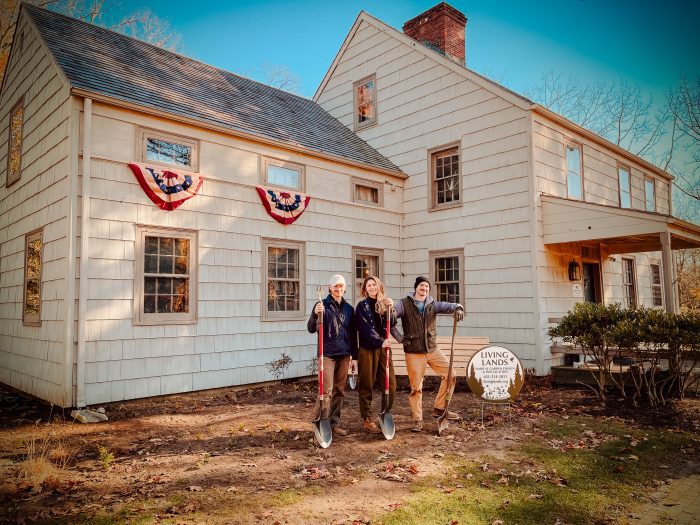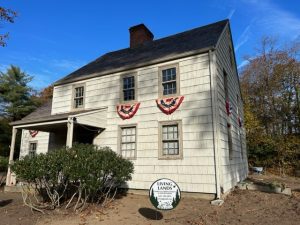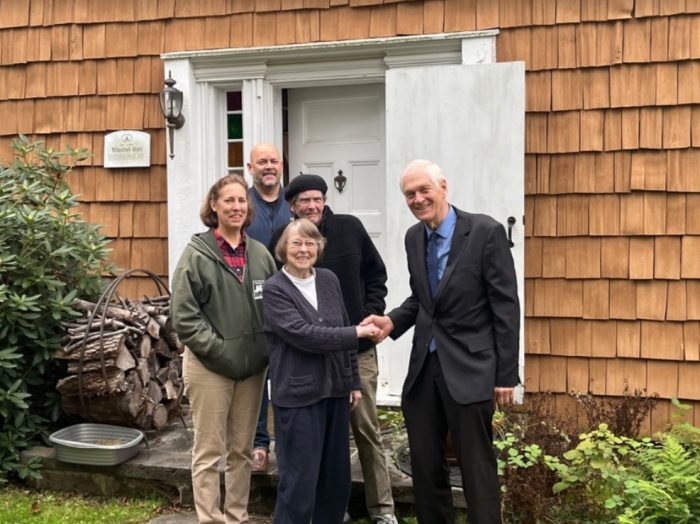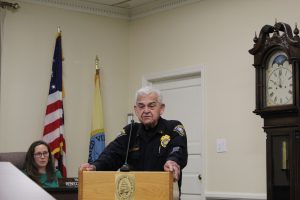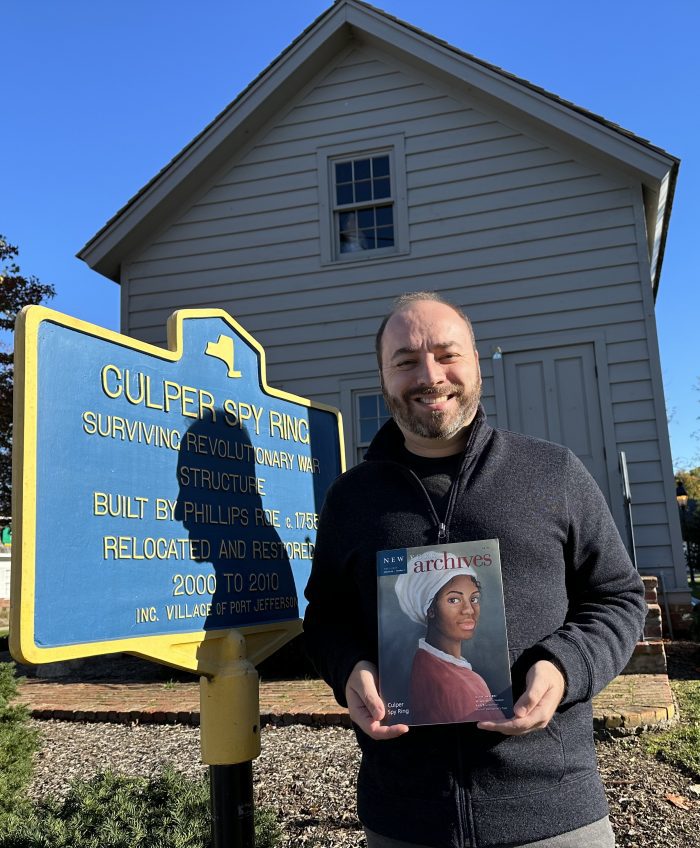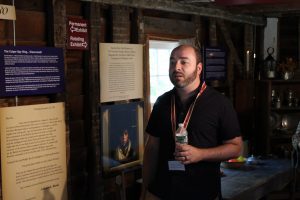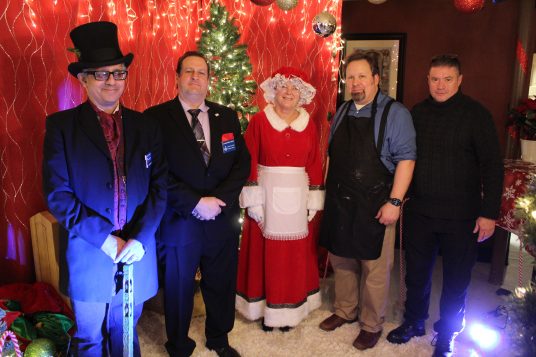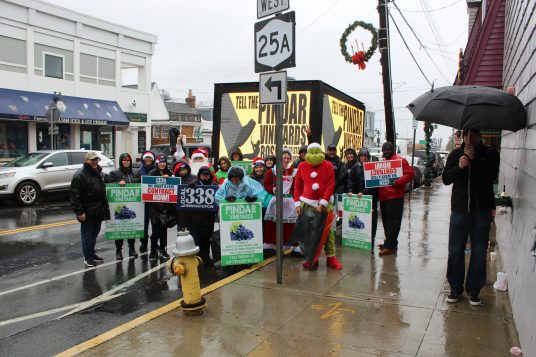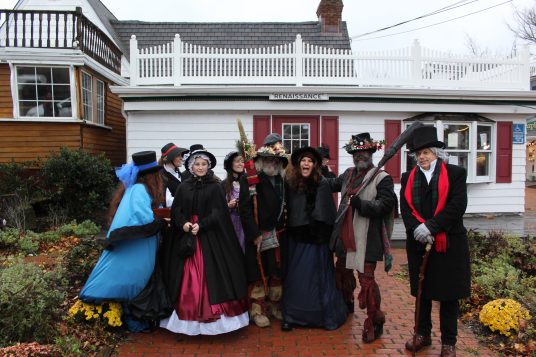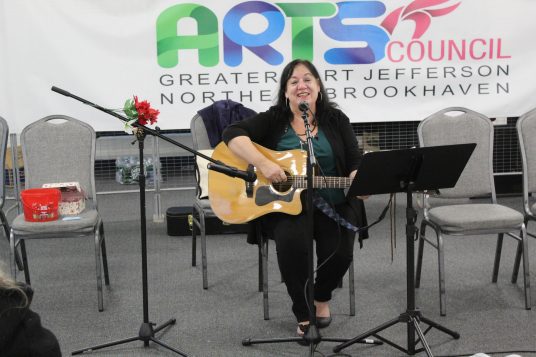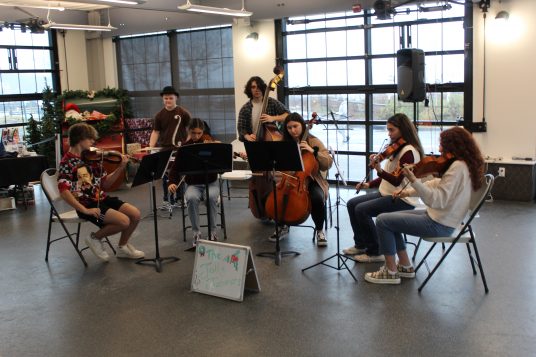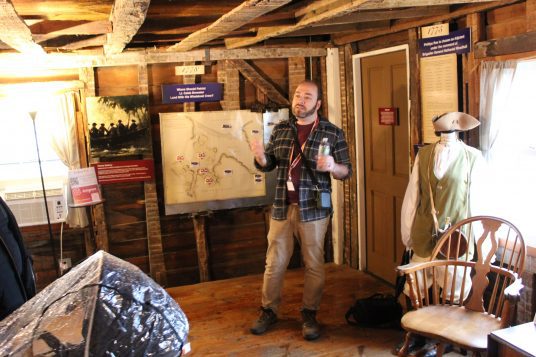By Beverly C. Tyler
Born in East Setauket in 1747, Caleb Brewster attended the one-room schoolhouse on the Village Green in Setauket. His classmates probably included other members of the Culper Spy Ring, Austin Roe, born 1748; Abraham Woodhull, 1750; and Benjamin Tallmadge, 1754. These friends trusted each other as children, later they would need to trust each other as Patriot spies.
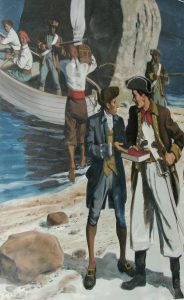
Photo by Bev Tyler, courtesy of Three Village Central School District
At 19, Brewster signed on a whaler bound for Greenland. When they returned, he shipped out on a merchant vessel crossing the Atlantic to London. Sometime in the early 1770s, by now an expert seaman and having trained as a blacksmith, he returned home, joined the Brookhaven Minutemen and took part in the 1776 Battle of Long Island in Brooklyn. With British forces controlling Long Island, Brewster joined the Continental Army and was soon commissioned as a Lieutenant of artillery. As a whaleboat captain, he joined in a couple of raids on Setauket.
In January 1777, Brewster was able to join an artillery company at Fairfield, Connecticut, directly across Long Island Sound from Setauket Harbor. With available resources and time, he put together a force of three whaleboats to attack British and Loyalist ships on the Sound and to gain intelligence on British activity on Long Island. He was able to report all this activity to his close friend Benjamin Tallmadge, a dragoon officer stationed near Fairfield.
In February 1777, General Washington tasked Tallmadge with running Long Island spy, Major John Clark, who operated on his own and provided good intelligence on the British on Long Island and in New York City. Washington recognized Tallmadge’s ability to gain valuable intelligence and made him second-in-command under intelligence chief General Scott. Tallmadge had Major Clark route his intelligence through Brewster who regularly traveled between Fairfield and Long Island. When Clark suddenly left Long Island in September 1777, it left Washington with only the intelligence reports from Brewster’s contacts on Long Island.
On 8 August 1778, General Washington wrote to Brewster, “Let me entreat that you will continue to use every possible means to obtain intelligence of the Enemys motions…and give me the earliest notice of their Sailing from the hook…this matter may be of great Importance to the French Fleet at, & the enterprize on, Rhode Island..and whether any Troops have Imbarked for Rhode Island or else where within these few days. I am Sir Yr Most Obedt Servt G. W——n.”
Later the same month, Washington agreed to Tallmadge’s plan to organize a spy ring based in Setauket that would route intelligence through Brewster and his whaleboats, a route already well-established from British Long Island to Patriot Connecticut.
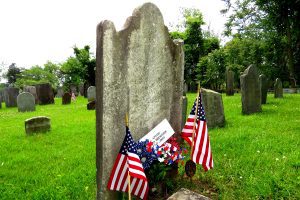
Robert Brush was a Long Island native who lived in Connecticut during the war. Brush wrote in his pension application, “I continued to go with Caleb for three or four years and the number of these expeditions varied from one to four times a month and lasted from two days to a week or more. The object was to get intelligence from the British…At one time we had a skirmish with a boat crew of a Privateer after they had landed on the Island…Another time we were lying on the Island concealed, a party of horse commanded by one Ishmael Youngs a Tory came in search of us and passed within fifty yards of our concealment but did not discover us.”
After the war, Brewster, as he did for so many of his men, reported that “Robert Brush was a good and brave soldier” and “frequently volunteered his services on different occasions under me during the war on difficult and dangerous services, whilst I was engaged in secret service in Long Island Sound by order of General Washington.”
Joshua Davis, in his pension application reported, “I remained in the New York Regiment but I was also detached and employed in what was called the whaleboat service. I was serving…on board a whaleboat under Captain Caleb Brewster, who commanded a small fleet.” He served until the end of the war.
Davis’s widow, Abigail, wrote that her husband, under the command of Capt. Brewster, went from Fairfield to Long Island, “for the purpose of getting Information from the enemy which service was performed in a Whale Boat as often as once a Week.” Her husband continued in the whaleboat service until the Peace.”
Brewster’s crews of sailors were recruited from the ranks of the men he commanded and a number of Long Island men like Davis and Brush. Brewster also had trusted associates including Lt. George Smith of Smithtown and Captain Abraham Cooper Woodhull, a cousin of Setauket’s spy chief Abraham Woodhull, who was captain of one of Brewster’s whaleboats.
In addition to twelve men, each whaleboat had a small swivel gun on the bow powerful enough to put a hole in an enemy boat below the waterline or disable a mast with a lucky shot when close in. Brewster’s three whaleboats were a potent fighting force, able to attack and capture the sloops, schooners and small British and Tory brigs that patrolled the sound or the plunderers, who regularly attacked residents on Long Island and along the Connecticut shoreline.
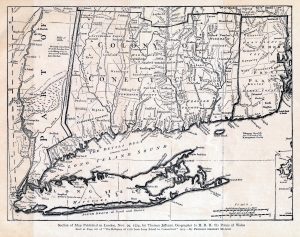
On December 7, 1782, Brewster and several of his whaleboats chased and attacked three enemy boats about mid-sound and captured two. Brewster was wounded when a musket ball went through his chest. He continued to fight until the enemy was captured and then collapsed. Every man on the enemy’s boats was either killed or wounded. Brewster spent many months recovering in the hospital in Black Rock. In February and March 1783, he took part in a battle off Stratford Point and commanded a Fairfield sloop which captured the British armed vessel “Fox”. Still not recovered from the boat fight, he returned home to convalesce. Brewster married Anne Lewis of Fairfield, Connecticut in 1784, and purchased a home and farm in Black Rock, Connecticut in 1788.
In 1793, Brewster was commissioned Lieutenant of the Revenue Cutter “Active”. He later became commander. In 1809, Capt. Brewster took a party of dignitaries, including the governor, on a pleasure cruise around Long Island and was later presented with a silver trophy cup which is now at the Fairfield Historical Society. Brewster retired from active service in 1816, and died in 1827 at the age of 79. Anne died in the cholera epidemic in 1834.
The story of Caleb Brewster, his whaleboats and crews, should be the subject of more stories that talk of bold actions and swift attacks, of boats and crews that appear and disappear into Long Island coves and across Long Island Sound, all the while providing vital intelligence to General Washington on British forces. The British never laid hands on Brewster, although he gave them plenty of opportunity.
Brewster was never officially recognized for his actions. Yet his trips across Long Island Sound occurred much more frequently than is recognized by the extant intelligence reports. Brewster became the linchpin for the Culper Spy Ring as he brought both verbal and written reports from British-held Long Island and New York City through Patriot-held Connecticut to General Washington.
Brewster and his crews were as vital to the American victory as the few U.S. Naval vessels and Continental Congress-authorized privateers, who gained lasting fame for their exploits up and down the Atlantic coast.
Beverly Tyler is Three Village Historical Society historian and author of books available from the Three Village Historical Society, 93 North Country Rd., Setauket, NY 11733. Tel: 631-751-3730. Website: TVHS.org



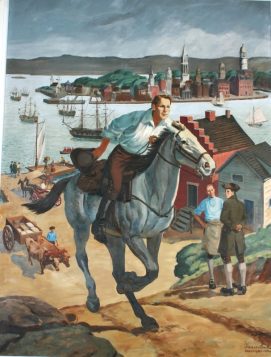

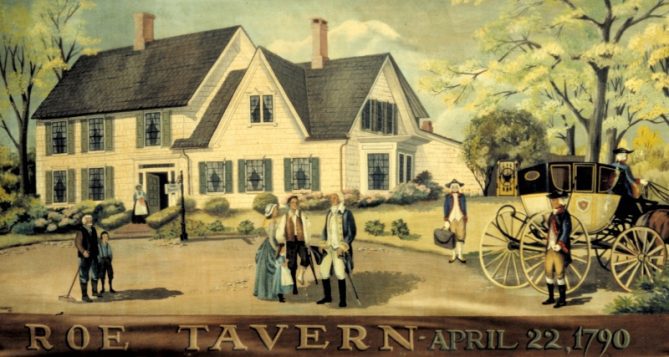



 Rachel and Joon have been best friends since kindergarten, when they bonded over a pirate fantasy. Now, eleven years old, in July, between fifth and sixth grade, they have decided to be spies. Additionally, the inseparable pair are facing Joon’s imminent move out of the district, both fearing the toll the distance will take on their friendship.
Rachel and Joon have been best friends since kindergarten, when they bonded over a pirate fantasy. Now, eleven years old, in July, between fifth and sixth grade, they have decided to be spies. Additionally, the inseparable pair are facing Joon’s imminent move out of the district, both fearing the toll the distance will take on their friendship.